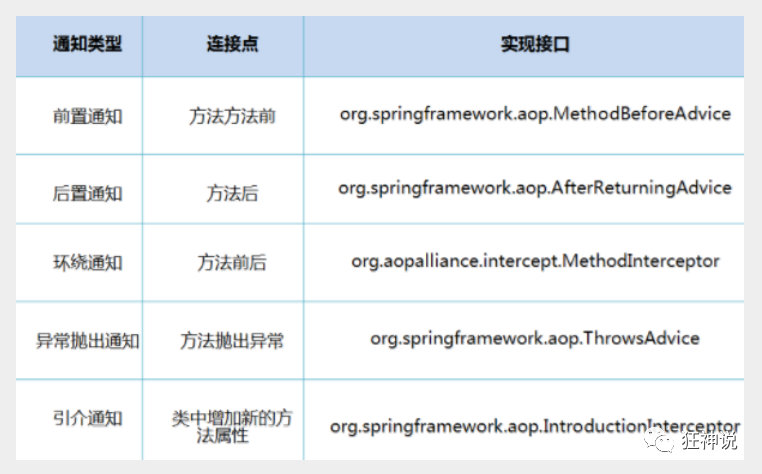AOP(Aspect Oriented Programming)意为:面向切面编程,通过预编译方式和运行期动态代理实现程序功能的统一维护的一种技术。AOP是OOP的延续,是软件开发中的一个热点,也是Spring框架中的一个重要内容,是函数式编程的一种衍生范型。利用AOP可以对业务逻辑的各个部分进行隔离,从而使得业务逻辑各部分之间的耦合度降低,提高程序的可重用性,同时提高了开发的效率。
提供声明式事务;允许用户自定义切面
横切关注点:跨越应用程序多个模块的方法或功能。即是,与我们业务逻辑无关的,但是我们需要关注的部分,就是横切关注点。如日志 , 安全 , 缓存 , 事务等等 ....
切面(ASPECT):横切关注点 被模块化 的特殊对象。即,它是一个类。
通知(Advice):切面必须要完成的工作。即,它是类中的一个方法。
目标(Target):被通知对象。
代理(Proxy):向目标对象应用通知之后创建的对象。
切入点(PointCut):切面通知 执行的 “地点”的定义。
连接点(JointPoint):与切入点匹配的执行点。
SpringAOP中,通过Advice定义横切逻辑,Spring中支持5种类型的Advice:

即AOP在不改变原有代码的情况下,去增加新的功能。
使用AOP织入,需要导入一个依赖包。
<dependency> <groupId>org.aspectj</groupId> <artifactId>aspectjweaver</artifactId> <version>1.9.4</version> </dependency>
第一种方式:
通过Spring API来实现,首先编写业务接口和实现类
public interface UserService { void add(); void delete(); void update(); void select(); } public class UserServiceImpl implements UserService{ @Override public void add() { System.out.println("增加一个用户"); } ? @Override public void delete() { System.out.println("删除一个用户"); } ? @Override public void update() { System.out.println("更新一个用户"); } ? @Override public void select() { System.out.println("查找一个用户"); } }
然后编写增强类,一个前置增强,一个后置增强
public class Log implements MethodBeforeAdvice { ? //method:要执行的目标的方法 //args:要调用的方法的参数 //target:目标对象 @Override public void before(Method method, Object[] args, Object target) throws Throwable { System.out.println(target.getClass().getName()+"的"+method.getName()+"方法被执行了"); } } public class AfterLog implements AfterReturningAdvice { // returnValue 返回值 // method 被调用的方法 // args 被调用的方法的对象的参数 // target 被调用的目标对象 @Override public void afterReturning(Object returnValue, Method method, Object[] args, Object target) throws Throwable { System.out.println("执行了"+target.getClass().getName()+"的"+method.getName()+"方法,"+"返回值:"+returnValue); } }
最后去spring的文件中注册,实现aop切入实现。
<?xml version="1.0" encoding="UTF-8"?> <beans xmlns="http://www.springframework.org/schema/beans" xmlns:xsi="http://www.w3.org/2001/XMLSchema-instance" xmlns:aop="http://www.springframework.org/schema/aop" xsi:schemaLocation="http://www.springframework.org/schema/beans http://www.springframework.org/schema/beans/spring-beans.xsd http://www.springframework.org/schema/aop https://www.springframework.org/schema/aop/spring-aop.xsd"> ? <!-- 注册bean--> <bean id="userService" class="com.aishimin.service.UserServiceImpl"/> <bean id="log" class="com.aishimin.log.Log"/> <bean id="afterlog" class="com.aishimin.log.AfterLog"/> ? <!-- AOP配置--> <aop:config> <!-- 切入点expression:表达式匹配要执行的方法--> <aop:pointcut id="pointcut" expression="execution(* com.aishimin.service.UserServiceImpl.*(..))"/> <!-- 环绕执行;advice-ref执行方法,pointcut-ref切入点--> <aop:advisor advice-ref="log" pointcut-ref="pointcut"/> <aop:advisor advice-ref="afterlog" pointcut-ref="pointcut"/> </aop:config> ? </beans>
测试:
第二种方式:
自定义类来实现Aop
目标业务类依旧是userServiceImpl
写一个自己的切入类
public class DiyPointCut { public void before(){ System.out.println("------方法执行前-------"); } public void after(){ System.out.println("------方法执行后-------"); } }
在spring中进行配置:
<!-- 注册bean--> <bean id="userService" class="com.aishimin.service.UserServiceImpl"/> <bean id="log" class="com.aishimin.log.Log"/> <bean id="afterlog" class="com.aishimin.log.AfterLog"/> <!-- 第二种方式自定义实现--> <!-- 注册bean--> <bean id="diy" class="com.aishimin.diy.DiyPointCut"/> <!-- aop的配置--> <aop:config> <!-- 第二种方式:使用AOP标签实现--> <aop:aspect ref="diy"> <aop:pointcut id="diyPointCut" expression="execution(* com.aishimin.service.UserServiceImpl.*(..))"/> <aop:before method="before" pointcut-ref="diyPointCut"/> <aop:after method="after" pointcut-ref="diyPointCut"/> </aop:aspect> </aop:config>
第三种方式实现:
使用注解实现
编写一个注解实现的增强类
@Aspect public class AnnotationPointCut { ? @Before("execution(* com.aishimin.service.UserServiceImpl.*(..))") public void before(){ System.out.println("方法执行前"); } ? @After("execution(* com.aishimin.service.UserServiceImpl.*(..))") public void after(){ System.out.println("方法执行后"); } ? public void around(ProceedingJoinPoint pj) throws Throwable{ System.out.println("环绕前"); System.out.println("签名:"+pj.getSignature()); Object proceed = pj.proceed(); System.out.println("环绕后"); System.out.println(proceed); } }
在spring配置文件中,注册bean,并增加支持注解的支持
<!-- 注册bean--> <bean id="userService" class="com.aishimin.service.UserServiceImpl"/> <bean id="log" class="com.aishimin.log.Log"/> <bean id="afterlog" class="com.aishimin.log.AfterLog"/> ? <!-- 第三种方式:注解实现--> <bean id="annotationPointcut" class="com.aishimin.diy.AnnotationPointCut"/> <aop:aspectj-autoproxy/>
通过aop命名空间的注解支持声明自动为spring容器中那些配置@aspectJ切面的bean创建代理,织入切面。当然,spring在内部依旧采用AnnotationAwareAspectJAutoProxyCreator进行自动代理的创建工作,但具体实现的细节已经被aop:aspectj-autoproxy/注解支持隐藏起来了。
原文:https://www.cnblogs.com/aishimin/p/14458639.html